Review MeeGo 1.0
Six months ago, I wrote about Moblin and specifically about Ubuntu Moblin Remix (RIP). As it turned out, the bright netbook future led by Moblin did not come and will not come. A new project is entering the arena - MeeGo, created on the basis of Moblin and Maemo.
The developers promised to release the first release in the second quarter of 2010, and they fulfilled their promise.
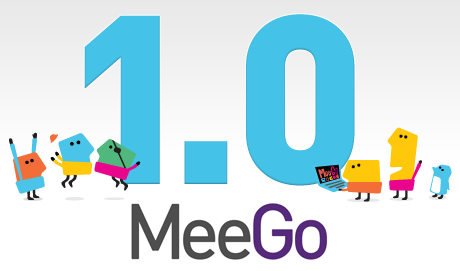
So, what did they do?
First a couple of words about what MeeGo is.
According to the developers themselves, “MeeGo unites the best of Moblin and Maemo in a multi-architecture platform covering an impressive part of various (mobile) devices.” It also states that MeeGo is a completely independent system built from scratch. Nevertheless, a more detailed study points to the roots of the good old Fedor (on which Moblin was founded at the time), but more on that later.
The architecture of MeeGo is clearly represented in the following picture:
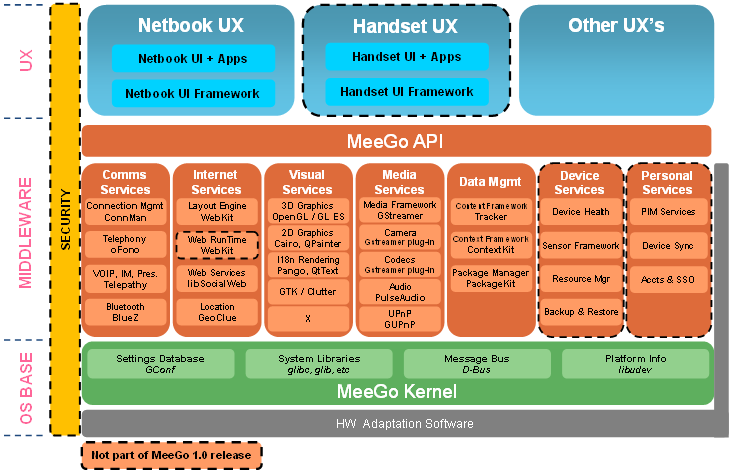
')
The release schedule of new releases is similar to the release of Ubuntu releases - every 6 months, and releases are planned to be divided into three releases:
• Intel Atom-based netbooks
• ARM-based Nokia N900
• Intel Atom-based in-vehicle
In fact, each option consists of a main platform and the so-called User Experience (UX), which is a special desktop environment and a set of software tailored to it.
By the way, MeeGo is rpm-based and, unfortunately, it will scare many in advance.
Another interesting fact is that btrfs is selected as the default file system. I personally see this choice as somewhat strange, because the FS is still under development.
Today, only the first version is officially released, for netbooks, and I, asnot the lucky owner of the Lenovo S10, settled on it.
It turned out that the netbook distribution is also presented in two variations - with the Chromium browser and with the Chrome browser. I didn’t see much of a difference (only the fact that in the distribution with Chrome I’ll have to agree with Google’s EULA) is mentioned, but I decided to download the release with Chromium.
When I wrote a review of the moblin, many reproached me for being limited and unwilling to deal with the existing problems, while I just wanted to show the general lack of preparation of the distribution for the average user. But so be it - in this review I will try to solve all possible problems with MeeGo. In general, in their presence, I did not doubt even before installation.
It's all quite simple. Download the image from here , write to a USB flash drive or disk (yes, that’s also possible) and install it, or download MeeGo right away. Detailed instructions can be found here .
MeeGo is loaded even from a flash drive just instantly, this is undoubtedly a huge plus. The installation is very simple and clear, no difficulties, so I will not dwell on it in more detail. I note only a very funny design and incomplete translation into Russian (forgive for the first time).
Installed (that is, pierced "Next"), loaded, answered a few simple questions and in theory you can work. Opanki ... There is no Wi-Fi. But how is it, because my netbook is on the list of tested hardware ? Well, broadcom chips and Linux are a separate topic for conversation. We fall into the console via ctrl-alt-f1, log in, and immediately see the ears, claws and tails of Fedora / RHEL / CentOS sticking out from everywhere. The fact that the distribution is based on Fedor, I have no doubt. Sysconfig, yum, system-config- * utilities are all in place, everything is very familiar.
Okay, compared to moblin now at least the wired connection works fine. And even the connection settings can be hammered with handles. Wonderful. However, it is still impossible to switch tabs between parameters. Probably this feature is planned for MeeGo 2.0.
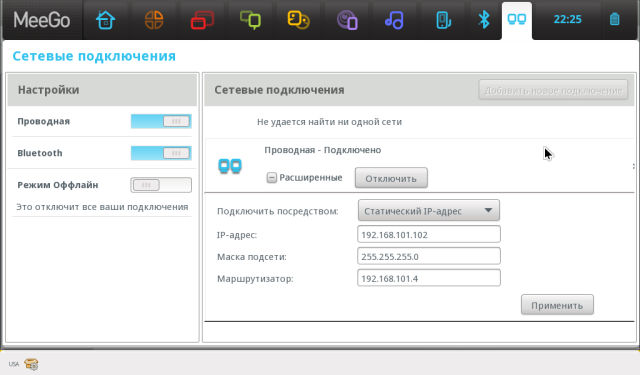
Yes, and yet, the local Connection Manager, even in the case of manual configuration, does not allow you to specify a DNS server. No problem. We stamp on the console and ...
Well, here we are on the Internet, we must somehow try to make a wifi.
It is necessary, that's just how? For yum, MeeGo uses its own repositories, which at the time of my picking with a netbook did not work. And here I was just shocked by the absence of wget. Luckily, curl was left in the system with a man's shoulder, but how can you install a driver with non-working turnips? Ndiswrapper? To download different rpmki and try to fasten it to the system? Build b43-fwcutter? Build b43 drivers? But as? Give me the kernel headers, give me gcc, give me anything!
Ladnenko, do without wifi, probably so conceived.
What we have there further ... Oh yeah, gprs modem. I insert my old ExpressCard modem from Cingular and wait ... You can wait indefinitely, nothing will change, the modem will not appear in the system. I do not even know which side to take on this problem - I have never had any problems with this modem.
And yet ... There are so-called “Parameters” in the system ( Applications > Standard > Parameters ) - never go there, it is fraught with unpleasant consequences. For example, turning on / off the notification area puts the system tightly and completely (it does not always work, but often). Nevertheless, the functionality is certainly impressive. For example, in the "Screen" section, you can customize displays and spotlights . This is certainly not such a big drawback, but in the light of the general state of MeeGo it only adds fun.
To be fair, it's worth noting that all the function keys and sound work perfectly, which can't be said about everything else.
And yet we are still on the Internet. Compared to Moblin, this is a huge leap forward, now there is a chance to evaluate all the bells and whistles without exception. Let's get started
I will not dwell on the interface, since it is exactly the same as the functionality of the moblin. Yes, what really is there, this is the moblin! Replaced only icons, which even now personally have almost no associations with the functions being performed (except, perhaps, bluetooth icons - it is quite recognizable).
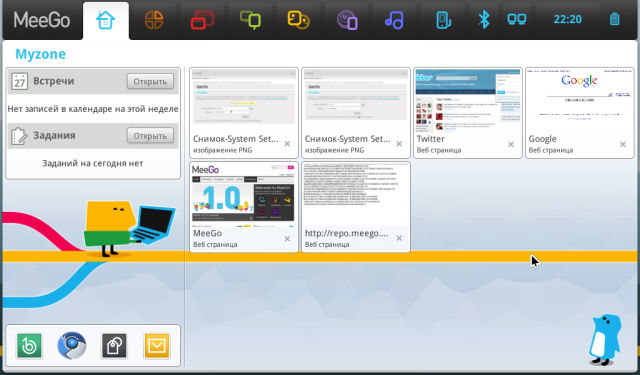
But this is all a matter of habit and memorization. Also, some frankly meaningless functions like the tab with the contents of the clipboard are also removed.
In the supported services, as before, only last.fm and twitter appear. I do not use Twitter, so the only option I need is last.fm. We hammer in login and the password, we poke "Enter" ... Iii ... It is deaf. No error messages, nothing at all.
Okay, I am registering my Twitter account, I’m filling in my username and password ... Yeah ... "Unable to sign in to Twitter." I check the login and password, I go to twitter through the browser - everything is fine. Well, apparently not destiny.
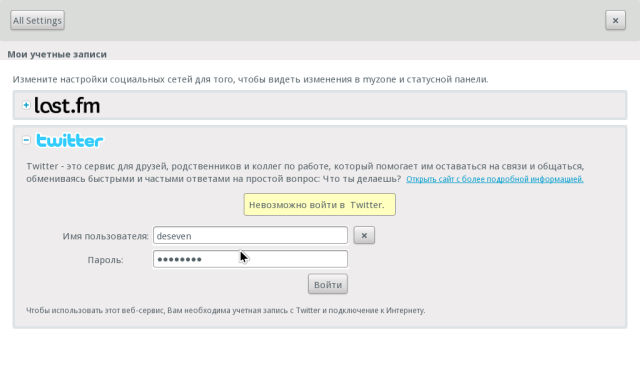
The IM client is represented by the usual Empathy, I think you should not dwell on it, I can only say that it works (it was probably too difficult to break it). The same can be said about the built-in Chromium.
The audio-video player is quite good and perfectly integrated into the system, only it does not know how to read mp3 or movies in any format (except for a certain one, in which the rather original MeeGo presentation is recorded).
The last nail in the coffin for me personally was the lack of support for flash drives with ntfs (fat32 is supported, but who needs it today?).
So, what do we have in the end? The standard devil-may-care attitude to iron support, idle integration even with the two services that are presented, a lot of minor flaws in the system and interface, and the overall unfinished business, which immediately catches the eye.
On the other hand, it’s a great interface, a very high download / work speed and the fact that the overall concept is really perfect for netbooks and laptops.
No, you can not use it, do not even try. In heel-another years, to MeeGo 6.0, it will probably be great (if it does not degenerate into any other, no less ambitious project).
I will never believe that Intel and Nokia together did not have enough strength and money to make a really good OS for mobile devices. This is very sad and has no excuse.
PS Nevertheless, I decided to hold MeeGo on my netbook for some time. Maybe the repositories will work, maybe some bugs will be fixed, maybe I will be given the opportunity to collect drivers for Wi-Fi. With this one could somehow live.
UPD1: The answer for Sergius about keyboard layouts. The only way to see and change them is to turn on the "notification area" (yes, the one that can hang the system).
UPD2: Solution for installing wifi , thanks for the link dzeban
UPD3: Turnips worked, now you can install wget and even all kinds of dev-tools, including kernel sources. Nevertheless, there is very little in the turnips, many of the necessary pieces are missing, however, given the fedor roots - I think you can safely put packages from Fedor 10-12. With the integration of services, it’s still dull, I managed to partially make last.fm work, on the Status tab it’s still written that services are not configured, but in myzone, the last listening of friends is displayed.
UPD4: A manual describing the addition of crutches for playing videos has already appeared on the official forum . While this is probably all, we will wait for updates.
The developers promised to release the first release in the second quarter of 2010, and they fulfilled their promise.

So, what did they do?
First a couple of words about what MeeGo is.
According to the developers themselves, “MeeGo unites the best of Moblin and Maemo in a multi-architecture platform covering an impressive part of various (mobile) devices.” It also states that MeeGo is a completely independent system built from scratch. Nevertheless, a more detailed study points to the roots of the good old Fedor (on which Moblin was founded at the time), but more on that later.
The architecture of MeeGo is clearly represented in the following picture:

')
The release schedule of new releases is similar to the release of Ubuntu releases - every 6 months, and releases are planned to be divided into three releases:
• Intel Atom-based netbooks
• ARM-based Nokia N900
• Intel Atom-based in-vehicle
In fact, each option consists of a main platform and the so-called User Experience (UX), which is a special desktop environment and a set of software tailored to it.
By the way, MeeGo is rpm-based and, unfortunately, it will scare many in advance.
Another interesting fact is that btrfs is selected as the default file system. I personally see this choice as somewhat strange, because the FS is still under development.
Today, only the first version is officially released, for netbooks, and I, as
It turned out that the netbook distribution is also presented in two variations - with the Chromium browser and with the Chrome browser. I didn’t see much of a difference (only the fact that in the distribution with Chrome I’ll have to agree with Google’s EULA) is mentioned, but I decided to download the release with Chromium.
When I wrote a review of the moblin, many reproached me for being limited and unwilling to deal with the existing problems, while I just wanted to show the general lack of preparation of the distribution for the average user. But so be it - in this review I will try to solve all possible problems with MeeGo. In general, in their presence, I did not doubt even before installation.
Installation
It's all quite simple. Download the image from here , write to a USB flash drive or disk (yes, that’s also possible) and install it, or download MeeGo right away. Detailed instructions can be found here .
MeeGo is loaded even from a flash drive just instantly, this is undoubtedly a huge plus. The installation is very simple and clear, no difficulties, so I will not dwell on it in more detail. I note only a very funny design and incomplete translation into Russian (forgive for the first time).
Customization
Installed (that is, pierced "Next"), loaded, answered a few simple questions and in theory you can work. Opanki ... There is no Wi-Fi. But how is it, because my netbook is on the list of tested hardware ? Well, broadcom chips and Linux are a separate topic for conversation. We fall into the console via ctrl-alt-f1, log in, and immediately see the ears, claws and tails of Fedora / RHEL / CentOS sticking out from everywhere. The fact that the distribution is based on Fedor, I have no doubt. Sysconfig, yum, system-config- * utilities are all in place, everything is very familiar.
Okay, compared to moblin now at least the wired connection works fine. And even the connection settings can be hammered with handles. Wonderful. However, it is still impossible to switch tabs between parameters. Probably this feature is planned for MeeGo 2.0.

Yes, and yet, the local Connection Manager, even in the case of manual configuration, does not allow you to specify a DNS server. No problem. We stamp on the console and ...
echo "nameserver 8.8.8.8" >> /etc/resolv.confWell, here we are on the Internet, we must somehow try to make a wifi.
It is necessary, that's just how? For yum, MeeGo uses its own repositories, which at the time of my picking with a netbook did not work. And here I was just shocked by the absence of wget. Luckily, curl was left in the system with a man's shoulder, but how can you install a driver with non-working turnips? Ndiswrapper? To download different rpmki and try to fasten it to the system? Build b43-fwcutter? Build b43 drivers? But as? Give me the kernel headers, give me gcc, give me anything!
Ladnenko, do without wifi, probably so conceived.
What we have there further ... Oh yeah, gprs modem. I insert my old ExpressCard modem from Cingular and wait ... You can wait indefinitely, nothing will change, the modem will not appear in the system. I do not even know which side to take on this problem - I have never had any problems with this modem.
And yet ... There are so-called “Parameters” in the system ( Applications > Standard > Parameters ) - never go there, it is fraught with unpleasant consequences. For example, turning on / off the notification area puts the system tightly and completely (it does not always work, but often). Nevertheless, the functionality is certainly impressive. For example, in the "Screen" section, you can customize displays and spotlights . This is certainly not such a big drawback, but in the light of the general state of MeeGo it only adds fun.
To be fair, it's worth noting that all the function keys and sound work perfectly, which can't be said about everything else.
And yet we are still on the Internet. Compared to Moblin, this is a huge leap forward, now there is a chance to evaluate all the bells and whistles without exception. Let's get started
Using
I will not dwell on the interface, since it is exactly the same as the functionality of the moblin. Yes, what really is there, this is the moblin! Replaced only icons, which even now personally have almost no associations with the functions being performed (except, perhaps, bluetooth icons - it is quite recognizable).

But this is all a matter of habit and memorization. Also, some frankly meaningless functions like the tab with the contents of the clipboard are also removed.
In the supported services, as before, only last.fm and twitter appear. I do not use Twitter, so the only option I need is last.fm. We hammer in login and the password, we poke "Enter" ... Iii ... It is deaf. No error messages, nothing at all.
Okay, I am registering my Twitter account, I’m filling in my username and password ... Yeah ... "Unable to sign in to Twitter." I check the login and password, I go to twitter through the browser - everything is fine. Well, apparently not destiny.

The IM client is represented by the usual Empathy, I think you should not dwell on it, I can only say that it works (it was probably too difficult to break it). The same can be said about the built-in Chromium.
The audio-video player is quite good and perfectly integrated into the system, only it does not know how to read mp3 or movies in any format (except for a certain one, in which the rather original MeeGo presentation is recorded).
The last nail in the coffin for me personally was the lack of support for flash drives with ntfs (fat32 is supported, but who needs it today?).
findings
So, what do we have in the end? The standard devil-may-care attitude to iron support, idle integration even with the two services that are presented, a lot of minor flaws in the system and interface, and the overall unfinished business, which immediately catches the eye.
On the other hand, it’s a great interface, a very high download / work speed and the fact that the overall concept is really perfect for netbooks and laptops.
No, you can not use it, do not even try. In heel-another years, to MeeGo 6.0, it will probably be great (if it does not degenerate into any other, no less ambitious project).
I will never believe that Intel and Nokia together did not have enough strength and money to make a really good OS for mobile devices. This is very sad and has no excuse.
PS Nevertheless, I decided to hold MeeGo on my netbook for some time. Maybe the repositories will work, maybe some bugs will be fixed, maybe I will be given the opportunity to collect drivers for Wi-Fi. With this one could somehow live.
UPD1: The answer for Sergius about keyboard layouts. The only way to see and change them is to turn on the "notification area" (yes, the one that can hang the system).
UPD2: Solution for installing wifi , thanks for the link dzeban
UPD3: Turnips worked, now you can install wget and even all kinds of dev-tools, including kernel sources. Nevertheless, there is very little in the turnips, many of the necessary pieces are missing, however, given the fedor roots - I think you can safely put packages from Fedor 10-12. With the integration of services, it’s still dull, I managed to partially make last.fm work, on the Status tab it’s still written that services are not configured, but in myzone, the last listening of friends is displayed.
UPD4: A manual describing the addition of crutches for playing videos has already appeared on the official forum . While this is probably all, we will wait for updates.
Source: https://habr.com/ru/post/94748/
All Articles